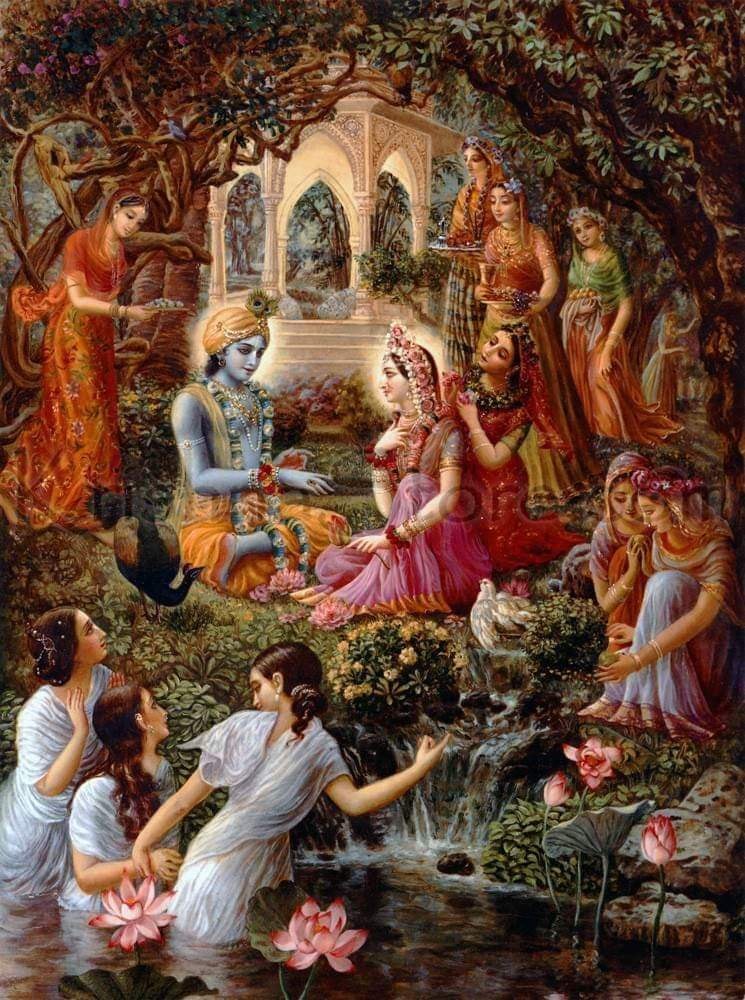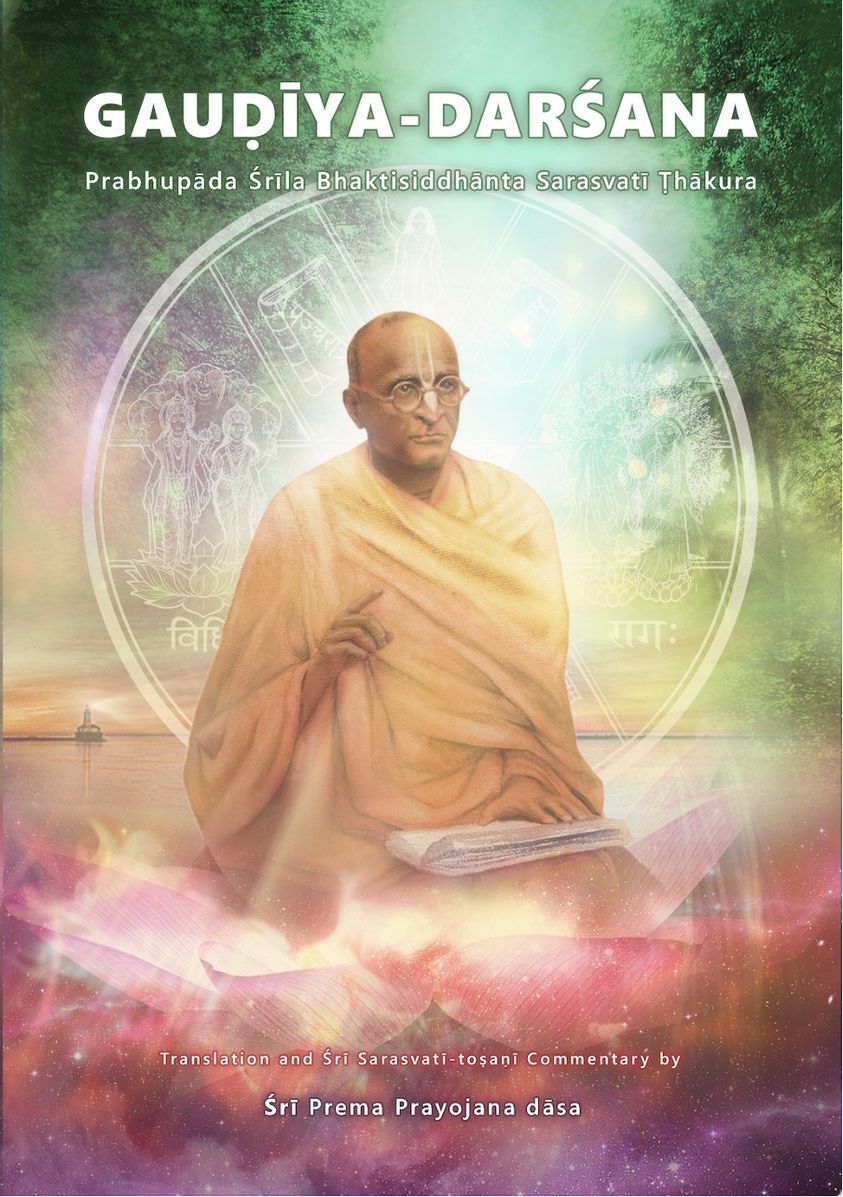The Solution to World Conflict
A speech delivered by Sri Srimad Bhaktivedanta Vamana Gosvami Maharaja on the 1st September 1983 at the Sri Meghalaya Gaudiya Matha, in Tura, India
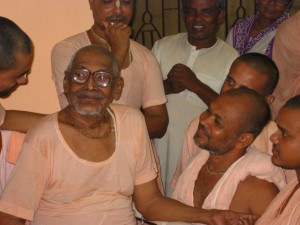
Sri Srimad Bhaktivedanta Vamana Gosvami Maharaja
Srila Vamana Maharaja:
"First of all I offer my unlimited prostrated obeisances at the lotus feet of my gurupadapadma,
jagad-guru nitya-lila-pravishta om vishnupada Srila Bhakti Prajnana Kesava Gosvami Maharaja, and my due pranamas and regards to the assembled Vaishnavas and wise listeners respectively.
Cheating Religions
The subject of our discussion today is sanatanadharma and the problems of the world; or, rather, sanatana-dharma as the solution to the problems of the world. We have up till now been hearing various learned speakers discuss the nature of sanatanadharma. We must begin by understanding that most of the dharmas, or types of socio-religious duties, prevalent in the world today are mundane and perishable.
prithivite yaha kichu dharma name cale
bhagavata kahe taha paripurna chale
Sri Vrindavana dasa Thakura
The Srimad-Bhagavatam condemns whatever goes on in this world in the name of dharma, or religion, as nothing but deception.
The various dharmas in this world deal with its mundane attributes. Sanatana-dharma, however, illuminates the function of the soul. It is the dharma in which the soul and the Supersoul, or Bhagavan, ,exist eternally. The soul bound in this world must investigate how he can be released. Is there any means for him to achieve such freedom?
Asking the Right Questions
Sri Sankaracarya has provided us a weapon to cut away our delusion in this regard in the following verse:
ka tava kanta kaste putrah
samsaro ’hyamativa vicitrah
kasya tvam va kuta ayatah
tattvam cintaya tadaidam bhratah
O brother, where were you before you came this? And after death where will you go? Did your dear relatives – your wife, son and other family members – come to this world with you? Can you take them with you when you leave? How long will you remain here? You should inquire into these philosophical truths.
This is precisely the subject of our deliberation and the realm of our sadhana, or spiritual practice. “Who are you?” “Where were you before coming to this world?” “For what purpose have you come here?” “What activities have you performed in your life so far and have they made you happy?”
The scriptures invite us to ask these questions. In this world, we are flanked by birth and death, and whatever we do in between these two is temporary. One poet has therefore written, “We are but actors on the stage of this world.” The human condition has also been described as follows:
yavajjananam tavan maranam
tavajjanani jathare sayanam
iti samsare sphutatara-doshah
kathama-iha manava tava santoshah
O human being, you have come to this world for some time, and after playing your part you must leave it. So long as there is birth there will also be death, and you will again have to enter into the womb of a mother. Whatever peace and happiness you hope to attain from this world is not real peace and happiness.
Therefore, in the scriptures on sanatana-dharma, the arya-rishis have said:
balas tavat kridasaktas
tarunas tavat taruni-raktah
vriddhas tavat cinta-magnah
parame brahmani ko ’pi na magnah
Sri Sankaracarya
In childhood one is engrossed in playing, in youth he becomes captivated by the opposite sex, and in age he becomes immersed in anxiety; thus henever becomes absorbed in thoughts of the Supreme Truth. In this world we pass our time eating, sleeping, defending and so on; rather, we should consider that the time allotted to us in this body is fixed.
![20101104bkmain[1]](http://www.harekrishnasociety.com/wp-content/uploads/2012/10/20101104bkmain1-300x198.jpg)
The Secret to World Unity and Peace
To develop love for Bhagavan, the supreme object of love, is the fundamental message of sanatanadharma. Thus far, we have discussed the temporary nature of religious activities, both bodily and mental. The dharma of the soul, however, is eternal. Today’s thinkers claim that the Twentieth Century is the age of science and mechanisation. However, there is no peace in today’s world. If this is indeed the great scientific age, why isn’t mankind attaining peace? There is a well-known saying in the West: “Science ends in philosophy and philosophy ends in religion.” The science referred to here is material science. Dharma, or religion, is the sole subject of our discussion today. Dharma can completely reverse the world’s present situation. In a religious assembly in the West, a Pope once admitted, “India guided by God can lead the world back to sanity.” Modern society is overridden by quarrel and dispute, and is completely demented. It can, however, be reformed by spiritual India, religious India.
The whole world is looking to the true inner spirit of India and its people; however, we Indians are so foolish and unlucky that we cannot understand this. Although we possess everything valuable, we are unable to utilise these assets properly. We are unable to embrace, as our life and soul, the contribution of our rishis, and thus our present plight is extremely miserable. How will we attain auspiciousness and peace so long as this wretched condition is not dispelled? If science could have delivered peace, it would indeed have deserved the credit. Where is peace? The last speaker mentioned the United Nations Organisation (UNO). This organization has taken responsibility for our welfare, but has it brought any peace to the world? When everything is driven by politics, can we ever hope to gain anything? The world today is divided into two camps, each willing to help anyone who submits to it. When such politics prevail, how can we ever offer the real recipe for peace? We will be unable to find it.
Unable to remedy the troubles facing humanity, the scientific and Western worlds are gripped by anxiety and fear. How can we, who are troubled by limitless problems, ever attain peace? We can never attain it simply by shouting, in various assemblies, “Peace! Peace!” However, our sanatana-rishis, or great sages on the path of sanatana-dharma, have given us a clue by which we may attain peace: if we love Bhagavan, the Supreme Controller, and place our faith in Him, all human beings will come to see themselves as part of a single race.
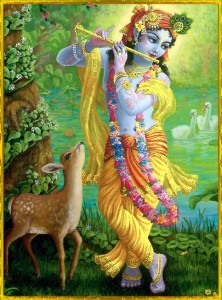
Who Classifies as Being Human?
Yesterday I explained the meaning of “man” or “human”. The arya-rishis have undertaken meticulous philosophical research into what is meant by the term “human”. One poet has written, “More than man you cannot be.” What does he mean? Does his use of the word “human” or “man” refer simply to facial features? No. When humaneness is lacking, man is known as a brute; and when humaneness is developed to its highest extent, a person is to be regarded as a human being. Such humaneness is divine. Why, then, are we not endeavouring to love Bhagavan, the embodiment of love, who is one without a second?
Three words are often used in the religious rhetoric of today – “equality”, “liberty” and “friendship”. How can we attain these qualities? How can we establish the true ideal of communism in the world? How can we demonstrate that one man is in universal brotherhood with another? Many people are quick to declare that we are all humans, but what is there to support this claim? Man’s humanity lies in his being governed by moral principles and ideals. Thus, only when we love Bhagavan can we love each and every living entity. How can one who does not even love his own father, mother or guardian, preach world-brotherhood?
These days, in an effort to create social unity, many people will try to say that the same blood flows through everyone’s veins. According to medical scientists, however, this claim is quite false. Blood is graded A, B, AB, O and so forth; a person cannot be given any type of blood. Thus, even in blood there is differentiation. It is therefore impossible to forge a universal brotherhood or socialism on the basis of this phenomenal world. How, then, can it be created? It can be established perfectly by considering how one can bring auspiciousness to the self through the process of selfrealization. The arya-rishis have described a type of communist ideal that is able to situate us in real universal brotherhood. We can never attain peace through mere material endeavours.
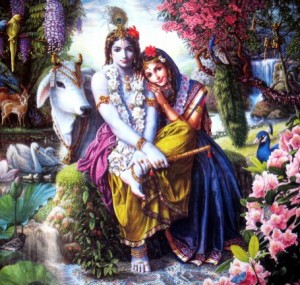
The Solution to All Problems
In the Gita, we see that Bhagavan Sri Krishna directs His instructions on self-realization to Arjuna. He did not, however, intend these teachings for Arjuna. By making His dear friend Arjuna His instrument, He instructs us all on how to treat the disease that is causing the entire world to suffer.
Arjuna asked, “How can one attain peace?” Sri
Krishna replied:
apuryamanam acala-pratishtham
samudram apah pravisanti yadvat
tadvat kama yam pravisanti sarve
sa santim apnoti na kama-kami
Bhagavad-gita (2.70)
Although countless rivers flow into the ocean, it never overflows. Similarly, various desires flow into the mind of one who is fixed in transcendence, yet his equilibrium is never disturbed. Such a person can attain peace, not he who strives always to fulfil his desires.
In this world our hopes and desires are endless. We are advised to limit our hankerings, because they have caused us to be afflicted by multifarious problems. If we do not control them we are not safe. In today’s world, it is indeed we who generate our own feelings of scarcity. We are at the root of our own vociferous complaints. Upon reflection, we see that we no longer feel the level of satisfaction we felt twenty or twenty-five years ago. Rather, our sense of scarcity has increased a million-fold. The sastras inform us that we will only attain peace when we put an end to this imagined sense of scarcity. But how will we find peace when this world is filled with restlessness? Sastra has provided a clue:
eva saranam gaccha
sarva-bhavena bharata
tat-prasadat param santim
sthanam prapsyasi sasvatam
Bhagavad-gita (18.62)
O scion of Bharata, surrender fully to the Supreme Lord in every respect. By His grace you will attain transcendental peace and the supreme and eternal abode.
Bhagavan is instructing His devotees “tam eva saranam gaccha – surrender unto Me.” Until a person does this he will never attain peace. As long as we think we can solve our own problems, we will be unable to discover a solution. Wherever we find a solution, we should embrace it. Bhagavan has given us instructions on “complete surrender” through the medium of the Gita, Bhagavatam, Vedas, Vedanta and so on, so that these teachings never escape our memory. The world’s unlimited problems, such as lack of food, clothing, accommodation and education, can be solved if we lead our lives by properly maintaining a focus on the original centre. This means establishing our trust in Bhagavan and our faith in and devotion to Him. Who is that Bhagavan? Is He devoid of form, qualities and variety? No, he is not devoid of potency. He has everything. He is saktiman, the possessor of all potency, and He has form and attributes. His form, which is composed of eternity, knowledge and bliss, is that of Syamasundara.
Sri Krishna is indeed that Bhagavan who is the embodiment of love. He can give love to unlimited jivas and He knows how to receive love from them. Only when we, the minutely conscious jivas, try to love Bhagavan, is it understood that our actual perception of ourselves (atma-darsana) has awakened fully. At that time we are able to execute our duty admirably and properly. Only by accepting the instructions of the arya-rishis and arya-sastras can all the problems of the world be resolved.
Translated from Sri Gaudiya Patrika, Year 35, Issue 10
by the Rays of The Harmonist team.
Published in English for the first time in Rays of The Harmonist No. 13 Karttika 2003

 Posted in
Posted in 






